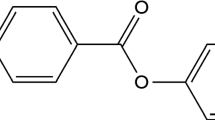Summary
The present study described an investigation on differential scanning calorimetry (DSC) for isotactic poly-4-methyl-pentene-1 (P4MP1) single crystals. DSC was carried out in the following three procedures: (a) The crystals grown isothermally at various temperatures in n-hexadecane. tetralin, p-xylene. and decalin were heated at a constant heating rate of 80°C/min; (b) Some samples of crystals were heated at four kinds of heating rate, 80, 40, 10, and 5°C/min; (c) The crystals used in the above experiment (b) were irradiated to 14 Mrads with60Co γ-ray. and these irradiated samples were heated at the same rate as in (b). Only the crystals from decalin revealed an endothermic peak in the vicinity of 80 °C (named as peak 1), which was concluded to originate from the solid-solid transition between two crystalline modifications. All crystals grown in various solvents gave a slightly observable endothermic peak in the vicinity of 125 °C (peak 2). The origin of peak 2, however, could not be determined whether it was based on a transition between crystalline modifications, or it merely reflected the abrupt change in the molecular motion at this temperature region. In high temperature region, two endothermic peaks that were inseparable from each other appeared (peak 3 and 4). The positions of peak 3 and 4, and the endothermic quantities of these peaks, from the above experiments (a). (b). and (c). were found to depend on crystallization condition and heating rate. These results could be explained well by considering that peak 3 corresponded to the melting of original single crystals, and peak 4 to the melting of the crystals with thicker lamellae that were formed in bulk during heating by partial melting and recrystallization. The introduction of the irradiation method helped us in investigating the origins of these four kinds of peak.
Zusammenfassung
Die vorliegende Studie beschreibt Untersuchungen mit Differentialthermoanalyse für isotaktische Poly-4-methyl-pentene-1 (P4MP1) Einkristallen. Die Differentialthermoanalyse wurde in folgender Weise ausgeführt. Erstens, die isotherm gewachsenen Kristalle der verschiedenen Temperaturen in n-Hexadecan, Tetralin, p-Xylol und Decalin wurden erhitzt mit konstanter Heizrate von 80°/min. Zweitens einige Kristallproben wurden bei 4 verschiedenen Heizgeschwindigkeiten 80. 40. 10 und 5°/min untersucht. Drittens die Kristalle in dem Experiment zwei wurden mit 14 Mrad einer Cobalt 60-Strahlungsquelle bestrahlt, und diese bestrahlten Proben wurden mit denselben Geschwindigkeiten wie in zwei erhitzt. Nur die Kristalle aus Decalin zeigten einen endothermen Peak in der Nachbarschaft von 80°, genannt Peak 1. Es wurde geschlossen, daß dieser Peak von einer Fest-Umwandlung zwischen zwei kristallinen Modifikationen herrührt. Alle Kristalle wurden gezüchtet aus den verschiedensten Lösungsmitteln und haben einen leicht beobachtbaren endothermen Peak in der Nachbarschaft von 125°. 2. Es konnte jedoch nicht festgestellt werden, ob dieser Peak 2 auch auf einer kristallinen Umwandlung zwischen Modifikationen beruht oder ob er nur eine plötzliehe Änderung in der molekularen Bewegung bei dieser Temperaturgegend andeutet. In höheren Temperaturbereichen treten zwei endotherme, nicht trennbare Peaks auf, Peak 3 und 4. Die Lagen von Peak 3 und 4 und die endtherme Größe dieser Peaks aus den Experimenten l, 2 und 3 waren abhängig von den Kristallisationsbedingungen und der Aufheizrate. Diese Ergebnisse lassen sich gut erklären durch die Betrachtung des Peak 3, der dem Schmelzen der Original-Einzelkristalle entspricht und Peak 4 dem Schmelzen der Kristalle mit dickeren Lamellen, die während des Aufheizens in der Masse durch partielles Schmelzen und Rekristallisation geformt wurden. Die Einführung der Bestrahlungsmethode half uns in der Peststellung des Ursprungs dieser 4 Arten von Peaks.
Similar content being viewed by others
References
Bair, H. E., R. Salovey, andT. W. Huseby, Polymer8, 9 (1967).
Mandelkern, L. andA. L. Allou, Polymer Letters4, 447 (1966).
Nakajima, A., S. Hayashi, andH. Nishimura, Kolloid-Z. u. Z. Polymere229, 107 (1969).
Kamide, K. andM. Sanada, Chem. High Polymer (Japan)24, 662 (1967).
Bair, H. E. andR. Salovey, Polymer Letters5, 429 (1967).
Tanda, Y., K. Imada, andM. Takayanagi, Kogyokagaku Zasshi69, 1971 (1966).Tanda, Y., N. Kawasaki, K. Imada, andM. Takayanagi, Reports on Progress in Polymer Physics in Japan9, 165 (1966).
Nakajima, A., S. Hayashi, andT. Taka, Kolloid-Z. u. Z. Polymere233, 869 (1969).
Morrow, D. R., G. C. Richardson, L. Kleinman, andA. E. Woodward, J. Polymer Sci.5, 493 (1967).
Rånby, B. G., K. S. Chan, andH. Brumberger, J. Polymer Sci.58, 545 (1962).
Hirai, N., Y. Yamashita, T. Mitsuhata, andY. Tamura, Lab. Surface Sci., Fac. Sci., Okavama Univ.2, 1 (1961).
Peterlin, A., J. Polymer Sci.B 2, 279 (1963); Polymer6, 25 (1965).
Hoffman, J. D., SPE Transactions4, 315 (1964).
Griffth, J. H. andB. G. Rånby, J. Polymer Sci.44, 369 (1960).
Litt, M., J. Polymer Sci.A 1, 2219 (1963).
Hellmuth, E. andB. Wunderlich, J. Appl. Phys.36, 3039 (1965).
Nakajima, A., S. Hayashi, T. Korenaga, andT. Sumida, Kolloid-Z. u. Z. Polymere222, 124 (1968).
Nakajima, A. andS. Hayashi, Kolloid-Z. u. Z. Polymere225, 116 (1968).
Fischer, E. W. andG. F. Schmidt, Angew. Chem.74, 551 (1962).
Author information
Authors and Affiliations
Additional information
The authors wish to express their appreciation to Dr.H.-D. Chu (Institute for Chemical Research, Kyoto University) and Mr.Y. Suzuki (Department of Polymer Chemistry. Kyoto University) for advice and help with60Co γ-ray irradiation, and to Dr.T. Arakawa and Mr.N. Arai (Fiber and Textile Research Institute, Teijin Limited) for valuable discussion and help with differential scanning calorimetry.
Rights and permissions
About this article
Cite this article
Nakajima, A., Hayashi, S. & Taka, T. Melting behavior of poly-4-methyl-pentene-1 single crystals. Kolloid-Z.u.Z.Polymere 233, 869–878 (1969). https://doi.org/10.1007/BF01508007
Received:
Issue Date:
DOI: https://doi.org/10.1007/BF01508007



